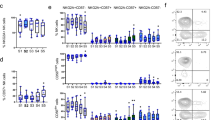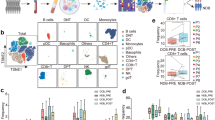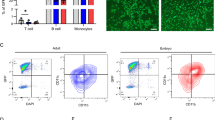Abstract
The objective of this study was to determine whether dietary ribonucleotides alter immune cell phenotypes or function in the first year of life. Newborn term infants in a double-blind, 12-mo, multicenter trial were randomized to cow milk formula groups with (FN, n = 138) or without (F, n = 147) 72 mg/L supplemental ribonucleotides. A nonrandomized HMF cohort (n = 192) was concurrently enrolled. Eighty-eight immune blood cell types were characterized by flow cytometry. Data were analyzed by multivariate ANOVA (MANOVA), ANOVA, and repeated measures analysis (RMA), with adjustments made for multiple comparisons. Ribonucleotide feeding changed subpopulations of T and natural killer (NK) cells. FN had higher numbers and percentages of memory/effector (M/E) cytotoxic/suppressor (CD45R0+CD8+, RMA) T, Fas+ M/E (CD45R0+CD95+CD3+, 6 mo) T, and CD56+CD16− NK cells (CD56+CD16−CD3−CD8−, 12 mo), and higher percentages of M/E helper (CD45R0+CD4+, RMA) T, Tc1 (IFNγ+CD4−CD3+, RMA), total interferon (IFN)γT (IFNγ+CD4+/−CD3+, RMA), Th2 (IL-4+CD4+CD3+, 7 mo), and CD57+ NK-T cells (CD57+CD56−CD3+, 6 mo, 7 mo) compared with F. Percentages of naive helper T (CD45RA+CD4+, 12 mo) and numbers and percentages of CD56+ NK-T cells (CD56+CD16−CD3+CD8−, 2 mo, 6 mo) were lower in FN than F. Percentages of M/E cytotoxic/suppressor, Th2, and CD56+CD16− NK cells in FN were significantly higher than F but were not different from HMF, whereas F was significantly lower than HMF. Ribonucleotide supplementation of infant formula supported increased T-cell maturation and affected immunoregulatory NK cell subsets. These FN-associated immune cell profiles either did not differ from those infants fed HMF or tended to be more like those fed HMF than those fed F.
Similar content being viewed by others
Log in or create a free account to read this content
Gain free access to this article, as well as selected content from this journal and more on nature.com
or
Abbreviations
- APC:
-
allophycocyanin
- CD:
-
cluster of differentiation
- ExHMF:
-
exclusive human milk-fed
- F:
-
formula without nucleotides
- FBS:
-
fetal bovine serum
- FN:
-
formula with supplemented nucleotides
- FSC:
-
forward light scatter
- HBSS:
-
Hanks' balanced salt solution
- Hib PRP:
-
Hib capsular polysaccharide (polyribosylribitol phosphate)
- Hib-TITER:
-
Haemophilus influenzae type b vaccine
- HMF:
-
human milk-fed
- IFN:
-
interferon
- M/E cell:
-
memory/effector cell
- NK cell:
-
natural killer cell
- PerCP:
-
peridinin chlorophyll protein
- RMA:
-
repeated measures analysis
- SSC:
-
side light scatter
- Staph:
-
Staphylococcus aureus
- SWI:
-
Similac with iron
- Tc cell:
-
cytotoxic T cell
- Th cell:
-
helper T cell
- WBC:
-
white blood cell
References
Dewey KG, Heinig MJ, Nommsen-Rivers LA 1995 Differences in morbidity between breast-fed and formula-fed infants. J Pediatr 126: 696–702
Wold AE, Adlerberth I 1998 Does breast-feeding affect the infant's immune responsiveness?. Act Paediatr 87: 19–22
Kuchan M, Winship T, Masor M 1998 Ribonucleotides in infant nutrition: effect on immune function. In Reifen R, Lerner A, Branski D, Heymans HAS (eds) Pediatric Nutrition. Karger, Basel 80–94
Carver JD 1999 Dietary nucleotides: effects on the immune and gastrointestinal systems. Acta Pediatr Suppl 430: 83–88
Manzano M, Abadia-Molina AC, Olivares EG, Gil A, Rueda R 2003 Dietary nucleotides accelerate changes in intestinal lymphocyte maturation in weanling mice. J Pediatr Gastroenterol Nutr 37: 453–461
Leach JL, Baxter JH, Molitor BE, Ramstack MB, Masor ML 1995 Total potentially available nucleosides of human milk by stage of lactation. Am J Clin Nutr 61: 1224–1230
Pickering LK, Granoff DM, Erickson JR, Masor ML, Cordle CT, Schaller JP, Winship TR, Paule CL, Hilty MD 1998 Modulation of the immune system by human milk and infant formula containing nucleotides. Pediatrics 101: 242–249
Yao KT, Huang CB, Chen W, Chen SJ, Chou YH, Huang FY, Kua KE, Chen N, McCue M, Alarcon PA, Tressler RL, Comer GM, Baggs G, Merritt RJ, Masor M 2003 Effect of nucleotides on diarrhea and immune responses in healthy term infants in Taiwan. J Pediatr Gastroenterol Nutr 36: 37–43
Carver JD, Pimentel B, Wiener DA, Lowell NE, Barness LA 1991 Infant feeding effects on flow cytometric analysis of blood. J Clin Lab Anal 5: 54–56
Hawkes JS, Neumann MA, Gibson RA 1999 The effect of breast feeding on lymphocyte sub populations in healthy term infants at 6 months of age. Pediatr Res 45: 648–651
Pabst HF, Spady DW, Pilarski LM, Carson MM, Beeler JA, Krezolek MP 1997 Differential modulation of the immune response by breast or formula-feeding of infants. Acta Pediatr 86: 1291–1297
Schaller JP, Kuchan MJ, Thomas DL, Cordle CT, Winship TR, Buck RH, Baggs GE, Wheeler JG 2004 Effect of dietary ribonucleotides on infant immune status. part 1: humoral responses. Pediatr Res 56: 883–890
American Academy of Pediatrics, Committee on Nutrition 1993 Pediatric Nutrition Handbook. American Academy of Pediatrics, Elk Grove, IL, 190: 36–361
Buck RH, Cordle CT, Thomas DJ, Winship TR, Schaller JP, Dugle JE 2002 Longitudinal study of intracellular T cell cytokine production in infants compared to adults. Clin Exp Immunol 128: 490–497
Kishimoto TK, Jutila MA, Berg EL, Butcher EC 1989 Neutrophil Mac-1 and MEL-14 adhesion proteins inversely regulated by chemotactic factors. Science 245: 1238–1241
Cordle CT, Winship TR, Schaller JP, Thomas DJ, Buck RH, Ostrom KM, Jacobs JR, Blatter MM, Cho S, Gooch WM III, Pickering LK 2002 Immune status of infants fed soy-based formulas with or without added nucleotides for 1 year: part 2: immune cell populations. J Pediatr Gastroenterol Nutr 34: 145–153
Lanzavecchia A, Sallusta F 2000 Dynamics of T lymphocyte responses: intermediates, effectors, and memory cells. Science 290: 92–97
Chipeta J, Komada Y, Zhang XL, Deguchi T, Sugiyama K, Azuma E, Sakurai M 1998 CD4+ and CD8+ cell cytokine profiles in neonate, older children, and adults: increasing T helper Type 1 and T cytotoxic Type 1 cell populations with age. Cell Immunol 183: 149–156
Naess LM, Oftung F, Aase A, Wetzler LM, Sandin R, Michaelsen TE 1998 Human T-cell responses after vaccination with the Norwegian group B meningococcal outer membrane vesicle. vaccine. Infect Immun 66: 959–965
Toyoda M, Ihara T, Nakano T, Ito M, Kamiya H 1999 Expression of interleukin-2 receptor alpha and CD45R0 antigen on T lymphocytes cultured with measles virus antigen, compared with humoral immunity in rubella vaccines. Vaccine 17: 1369–1375
Najera O, Gonzalez C, Toledo G, Lopez L, Cortes E, Betancourt M, Ortiz R 2001 CD45RA and CD45R0 isoforms in infected malnourished and infected well-nourished children. Clin Exp Immunol 126: 461–465
Penna A, Artini M, Cavalli A, Levrero M, Bertoletti A, Pilli M, Chisari FV, Rehermann B, Del Prete G, Fiaccadori F, Ferrari C 1996 Long-lasting memory T cell responses following self-limited acute hepatitis B. J Clin Invest 98: 1185–1194
Juhela S, Hyoty H, Uibo R, Meriste SH, Uibo O, Lonnrot M, Halminen M, Simell O, Ilonen J 1999 Comparison of enterovirus-specific cellular immunity in two populations of young children vaccinated with inactivated or live poliovirus vaccines. Clin Exp Immunol 117: 100–105
Aberle JH, Aberle SW, Dworzak MN, Mandl CW, Rebhandl W, Vollnhofer G, Kundi M, Popow-Kraupp T 1999 Reduced interferon-γ expression in peripheral blood mononuclear cells of infants with severe respiratory syncytial virus disease. Am J Respir Care Med 160: 1263–1268
Romagnani S 1995 Biology of human Th1 and Th2 cells. J Clin Immunol 15: 121–125
Field CL, Thomson CA, Van Aerde JE, Parrott A, Euler A, Lien E, Clandinin MT 2000 Lower proportion of CD45R0+ cells and deficient interleukin-10 production by formula-fed infants, compared with human-fed, is corrected with supplementation of long-chain polyunsaturated fatty acids. J Pediatr Gastroenterol Nutr 31: 291–299
Ostrom KM, Cordle CT, Schaller JP, Winship TR, Thomas DJ, Jacobs JR, Blatter MM, Cho S, Gooch WM III, Granoff DM, Faden H, Pickering LK 2002 Immune status of infants fed soy-based formulas with or without added nucleotides for 1 year: part 1: vaccine responses, and morbidity. J Pediatr Gastroenterol Nutr 34: 137–144
Jyonouchi H, Sun S, Abira T, Winship T, Kuchan MJ 2000 Dietary nucleotides modulate antigen-specific type 1 and type 2 t-cell responses in young c57bl/6 mice. Nutrition 16: 442–446
Jyonouchi H, Sun S, Winship T, Kuchan MJ 2001 Dietary ribonucleotides modulate type 1 and type 2 T-helper cell responses against ovalbumin in young BALB/cJ mice. J Nutr 131: 1165–1170
Jyonouchi H, Sun S, Winship T, Kuchan MJ 2003 Dietary ribonucleotides increase antigen-specific Type 1 T-helper cells in the regional draining lymph nodes in young BALB/cJ mice. Nutrition 19: 41–46
Cooper MA, Fehniger TA, Caligiuri MA 2001 The biology of human natural killer-cell subsets. Trends Immunol 22: 633–640
Godfrey DI, Hammond KJ, Poulton LD, Smyth MJ, Baxter AG 2000 NKT cells: facts, functions and fallacies. Immunol Today 21: 573–583
Solana R, Mariani E 2000 NK and NT/T cells in human senescence. Vaccine 18: 1613–1620
Hebib C, Leroy E, Rouleau M, Fornairon S, Metivier D, Hirsch F, Kroemer G, Legendre C, Senik A, Charpentier B 1998 Pattern of cytokine expression in circulating CD57+ T cells from long-term renal allograft recipients. Transpl Immunol 6: 39–47
Weekes MP, Wills MR, Mynard K, Hicks R, Sissons JG, Carmichael AJ 1999 Large clonal expansions of human virus-specific memory cytotoxic T lymphocytes within the CD57+ CD28-CD8+ T cell population. Immunology 98: 443–449
Musha N, Yoshida Y, Sugahara S, Yamagiwa S, Koya T, Watanabe H, Hatakeyama K, Abo T 1998 Expansion of CD56+ NK T and γδ T cells from cord blood of human neonates. Clin Exp Immunol 113: 220–228
Okada T, Ilai T, Kawachi Y, Moroda T, Takii Y, Hatakeyama K, Abo T 1995 Origin of CD57+ T cells which increase at tumor sites in patients with colorectal cancer. Clin Exp Immunol 102: 159–166
Acknowledgements
The authors thank Amy Bates, Joe Laco, Pete Yakimovich, Karen Goehring, Melissa Nameth, Pam Newton, R.N., Tim Murphy, M.S., John Lasekan, Ph.D., and Peter Hu, Ph.D. for technical assistance, and Marc Masor, Ph.D. for editorial review. We also thank the following physicians who participated in this study: Wilson Andrews, Mark Blatter, Iqbal Choudhry, David Ferrera, William Forti, Martin Greenberg, Terry Jefferson, Susan Kerns, Jacob Lohr, Edgardo Malacaman, Michael Pichichero, Bruce Pistorius, Robert Reis, Allan Robinson, Laurie Schnell, and Michael Smith.
Author information
Authors and Affiliations
Corresponding author
Additional information
Supported by grants from the Ross Products Division of Abbott Laboratories.
Rights and permissions
About this article
Cite this article
Buck, R., Thomas, D., Winship, T. et al. Effect of Dietary Ribonucleotides on Infant Immune Status. Part 2: Immune Cell Development. Pediatr Res 56, 891–900 (2004). https://doi.org/10.1203/01.PDR.0000145577.03287.FA
Received:
Accepted:
Issue date:
DOI: https://doi.org/10.1203/01.PDR.0000145577.03287.FA
This article is cited by
-
Dietary nucleotide improves markers of immune response to strenuous exercise under a cold environment
Journal of the International Society of Sports Nutrition (2013)
-
Lactation and Neonatal Nutrition: Defining and Refining the Critical Questions
Journal of Mammary Gland Biology and Neoplasia (2012)
-
Dietary deoxynucleic acid induces type 2 T-helper immune response through toll-like receptor 9 in mice
European Journal of Nutrition (2011)
-
Controversies in neonatal nutrition: docosahexanoic acid (DHA) and nucleotides
Journal of Perinatology (2007)
-
Effect of dietary nucleotide supplementation on growth and immune function in term infants: a randomized controlled trial
European Journal of Clinical Nutrition (2006)



